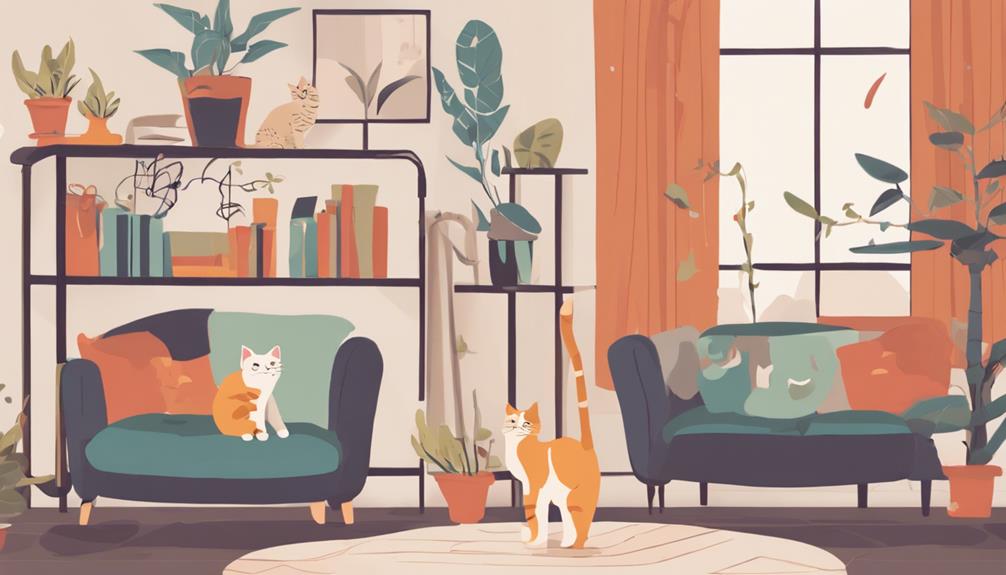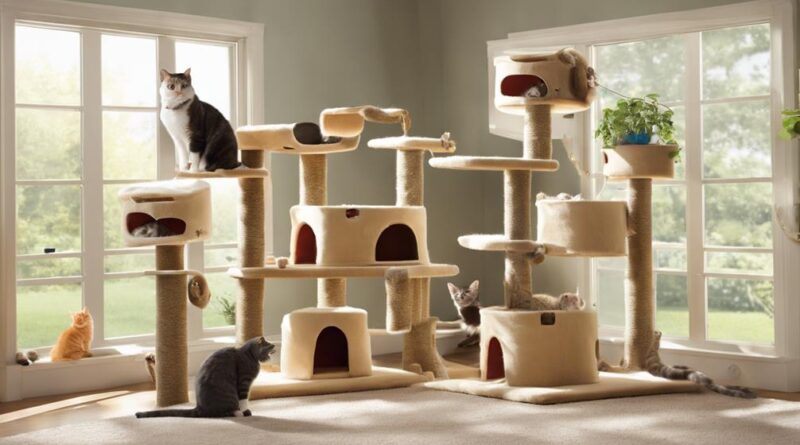Keeping Your Indoor Cats Happy: Simple Steps
If you've ever felt like your indoor cat is as curious as a detective on a case, you're not alone. But have you ever wondered how to keep your feline friend content and engaged within the confines of your home?
By implementing a few simple strategies, you can ensure your indoor cat's happiness and well-being thrive. From enriching their environment to providing mental stimulation and exercise, there are key steps you can take to make your indoor cat's life fulfilling.
Benefits of Indoor Living
If you want your indoor cat to thrive, providing a safe and secure environment is essential. Keeping your feline friend indoors can lead to improved behavior and health benefits. Indoor cats are less likely to encounter dangers such as traffic, predators, or contagious diseases. By eliminating these risks, indoor living can contribute to a longer and healthier life for your beloved pet.
Behaviorally, indoor cats tend to be more relaxed and have fewer stressors compared to outdoor cats. They aren't exposed to territorial disputes with other animals or the dangers of getting lost. This sense of security can lead to improved behavior, such as reduced aggression or anxiety. Additionally, indoor cats are at a lower risk of getting into fights, which can result in injuries or infections.
Health benefits of indoor living include a reduced likelihood of contracting parasites like fleas or ticks. Indoor cats are also less exposed to toxins from plants, chemicals, or other hazardous substances found outdoors. By controlling their environment, you can ensure that your cat has a balanced diet and stays hydrated, contributing to their overall well-being.
Enrichment Activities for Cats
To keep your indoor cat engaged and mentally stimulated, provide a variety of enrichment activities. Interactive toys are a fantastic way to keep your feline friend entertained. Toys that move or make sounds can mimic the thrill of hunting prey, engaging your cat's natural instincts. Consider toys that encourage your cat to chase, pounce, or swat, providing both physical exercise and mental stimulation.
Puzzle feeders are another excellent option to keep your indoor cat mentally sharp. These feeders make mealtime more engaging by requiring your cat to solve a puzzle to access their food. Not only does this provide mental stimulation, but it also slows down their eating, reducing the risk of digestive issues and obesity.
Rotate your cat's toys and puzzle feeders regularly to prevent boredom. Introducing new items periodically can reignite your cat's interest and keep them engaged. Additionally, set aside dedicated playtime each day to interact with your cat using these enrichment activities. Your active participation can enhance the bond between you and your feline companion while providing essential mental and physical stimulation.
Importance of Vertical Space
Keeping your indoor cat mentally and physically engaged extends beyond toys and puzzles; providing ample vertical space is crucial for their well-being. Cats are natural climbers and jumpers, and having access to climbing structures in your home allows them to exhibit these natural behaviors. Vertical territory is essential for cats as it provides them with a sense of security, allowing them to survey their surroundings and escape potential threats.
Investing in cat trees, shelves, or wall-mounted perches can significantly enhance your cat's environment. These structures not only serve as a means for your cat to climb and explore but also offer cozy spots for them to rest and observe the world from above. By incorporating various vertical elements, you're effectively expanding your cat's living space, promoting physical activity, and providing mental stimulation.
Creating a vertical territory for your indoor cat can help prevent behavioral issues such as boredom, stress, or even aggression. Cats that lack vertical space may exhibit destructive behaviors or become withdrawn. By offering them opportunities to climb and perch up high, you're supporting their natural instincts and overall well-being.
Creating Safe Outdoor Experience
How can you ensure your indoor cat has a safe outdoor experience? Here are some simple steps to create a secure outdoor environment for your feline friend:
- Outdoor Enclosures: Invest in outdoor enclosures or catio structures that allow your indoor cat to experience the outdoors safely. These enclosures provide a protected space where your cat can enjoy the fresh air, bask in the sun, and watch the birds without the risks associated with roaming free.
- Cat Safe Plants: When setting up your outdoor space for your indoor cat, make sure to include cat-safe plants. Cats are curious by nature and may nibble on plants, so it's essential to choose greenery that's non-toxic to felines. Some examples of cat-safe plants include catnip, mint, wheatgrass, and spider plants.
- Secure Boundaries: Ensure that the boundaries of your outdoor space are secure to prevent your indoor cat from escaping or encountering potential dangers. Check for any gaps in fences or enclosures that your cat could slip through, and make sure gates are always closed and latched securely.
Providing Mental Stimulation
Invest in interactive toys and puzzle feeders to engage your indoor cat's mind and prevent boredom. Interactive toys, such as feather wands, laser pointers, and treat balls, provide mental stimulation by encouraging your cat to chase, pounce, and problem-solve. These toys mimic hunting behaviors and keep your cat entertained for hours. Puzzle feeders are another great way to challenge your cat's mind. These feeders dispense food when your cat figures out how to manipulate the puzzle, turning mealtime into a fun and mentally stimulating activity.
Rotate your cat's toys regularly to keep them exciting and engaging. Cats can quickly lose interest in toys that are always out, so introducing new toys or hiding away some favorites and swapping them out periodically can reignite your cat's curiosity. Additionally, consider creating DIY puzzle feeders using items like toilet paper rolls or egg cartons. These homemade feeders can be filled with kibble or treats, encouraging your cat to work for their food and keeping them mentally engaged.
Indoor Cat Exercise Ideas
To ensure your indoor cat stays healthy and happy, incorporating regular exercise into their daily routine is essential. Here are some simple indoor cat exercise ideas to keep your feline friend active and entertained:
- Interactive Toys: Invest in interactive toys such as feather wands, laser pointers, or treat dispensing balls. These toys can stimulate your cat's natural hunting instincts and provide mental and physical exercise. Rotate the toys regularly to keep the playtime engaging.
- Playtime Routines: Establish daily playtime routines with your cat. Set aside at least 10-15 minutes a few times a day to engage in interactive play. Use toys that encourage jumping, pouncing, and chasing to keep your cat moving and engaged. This not only helps with exercise but also strengthens the bond between you and your pet.
- Obstacle Courses: Create simple obstacle courses using boxes, tunnels, or furniture. Encourage your cat to navigate through the course by placing treats or toys at various points. This activity promotes physical activity and mental stimulation, keeping your indoor cat entertained and active.
Socialization Tips for Cats

To help your indoor cat thrive and maintain a healthy well-being beyond physical exercise, considering socialization tips can greatly enhance their overall happiness and mental stimulation. Playtime routines are essential for your cat's social development. Set aside dedicated time each day to engage in interactive play sessions. Use interactive toys such as feather wands, laser pointers, or puzzle feeders to keep your cat mentally stimulated and physically active.
Interactive toys play a crucial role in fostering bonds between you and your cat. These toys not only provide mental enrichment but also encourage physical activity, preventing boredom and potential behavior issues. Rotate the toys regularly to maintain your cat's interest and prevent them from losing novelty.
Incorporating playtime routines into your daily schedule can strengthen your cat's social skills and prevent feelings of loneliness or isolation. Cats are intelligent animals that require mental stimulation and social interaction to thrive. By engaging in interactive play sessions and providing a variety of toys, you can ensure that your indoor cat remains happy, healthy, and well-socialized. Remember, a well-socialized cat is a content cat.
Monitoring Health and Well-being
Regularly monitoring your indoor cat's health and well-being is essential for ensuring their overall happiness and quality of life. Here are some key steps to help you keep your feline friend in top shape:
- Regular Check-ups: Just like humans, cats need regular visits to the veterinarian to ensure they're healthy. Annual check-ups can help catch any potential health issues early on, leading to better outcomes. Vaccinations, dental care, and parasite prevention are all crucial aspects of these visits.
- Mental Health Monitoring: Cats can experience stress, anxiety, and even depression. Keep an eye on your cat's behavior for any changes that could indicate mental distress. Providing environmental enrichment, such as interactive toys, scratching posts, and cozy hiding spots, can help keep your cat mentally stimulated and happy.
- Observation and Interaction: Spend quality time observing your cat's daily activities and interactions. Notice if they're eating well, using the litter box regularly, and engaging in play. Also, make time for interactive play sessions to strengthen your bond and ensure your cat is getting enough exercise.
Frequently Asked Questions
Can Indoor Cats Still Get Enough Vitamin D Without Going Outside?
You can ensure your indoor cat gets enough vitamin D without going outside. Vitamin D supplements offer benefits your cat needs for good health.
While sunbathing is a natural source, alternatives like special lights or windows can provide necessary UV rays.
How Often Should I Change up My Indoor Cat's Toys and Enrichment Activities?
To keep your indoor cat engaged and happy, it's essential to regularly rotate their toys and vary their enrichment activities.
Changing up their playthings frequently and scheduling playtime can prevent boredom and provide mental stimulation. Aim to introduce new toys and activities every few weeks to keep your feline friend entertained and mentally sharp.
This practice ensures a dynamic environment for your indoor cat, promoting their overall well-being and happiness.
Are There Any Specific Plants That Are Safe for Indoor Cats to Have in Their Environment?
When it comes to indoor gardening and having a pet-friendly environment for your cat, it's crucial to be mindful of the plants you choose.
Opt for cat-friendly plants that are safe for your feline friend to be around. Avoid toxic plants that could harm your cat if ingested.
How Can I Help My Indoor Cat Maintain a Healthy Weight?
To help your indoor cat maintain a healthy weight, focus on providing indoor exercise and a healthy diet. Encourage playtime with interactive toys or climbing structures to keep them active.
Monitor their food intake and opt for high-quality, portion-controlled meals. Consider puzzle feeders to slow down eating and promote mental stimulation.
Regularly engage in activities to keep your cat moving and maintain their weight for overall health and well-being.
What Are Some Signs That My Indoor Cat May Be Experiencing Stress or Anxiety?
If your indoor cat is feeling stressed or anxious, keep an eye out for behavioral changes like excessive grooming, hiding, or aggression. These symptoms can indicate your cat isn't feeling their best.
To help them cope, create a safe and calm environment, provide plenty of enrichment activities, and establish a routine. Regular play sessions and interactive toys can also help alleviate stress and anxiety in your indoor cat.
Conclusion
Keep your indoor cat happy by providing plenty of enrichment activities, vertical space, and mental stimulation. Remember to monitor their health and well-being, and consider safe outdoor experiences like a catio.
Socialize with your cat regularly and incorporate exercise into their daily routine. By taking these simple steps, you can ensure that your indoor cat leads a fulfilling and happy life.
